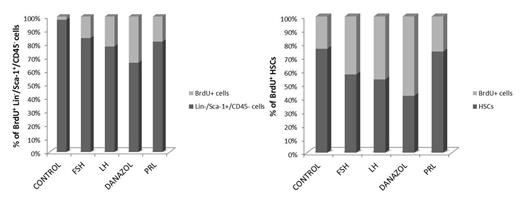Abstract
Hematopoietic stem/progenitor cells (HSPCs) are exposed in vivo to several growth factors, cytokines, chemokines, and bioactive lipids in bone marrow (BM) in addition to various sex hormones circulating in peripheral blood (PB). It is known that androgen hormones (e.g., danazol) is employed in the clinic to treat aplastic anemia patients. However, the exact mechanism of action of sex hormones secreted by the pituitary gland or gonads is not well understood. Therefore, we performed a complex series of experiments to address the influence of pregnant mare serum gonadotropin (PMSG), luteinizing hormone (LH), follicle-stimulating hormone (FSH), androgen (danazol) and prolactin (PRL) on murine hematopoiesis. In particular, from a mechanistic view we were interested in whether this effect depends on stimulation of BM-residing stem cells or is mediated through the BM microenvironment.
To address this issue, normal 2-month-old C57Bl6 mice were exposed or not to daily injections of PMSG (10 IU/mice/10 days), LH (5 IU/mice/10 days), FSH (5 IU/mice/10 days), danazol (4 mg/kg/10 days) and PRL (1 mg/day/5days). Subsequently, we evaluated changes in the BM number of Sca-1+Lin–CD45– that are precursors of long term repopulating hematopoietic stem cells (LT-HSCs) (Leukemia 2011;25:1278–1285) and bone forming mesenchymal stem cells (Stem Cell & Dev. 2013;22:622-30) and Sca-1+Lin–CD45+ hematopoietic stem/progenitor cells (HSPC) cells by FACS, the number of clonogenic progenitors from all hematopoietic lineages, and changes in peripheral blood (PB) counts. In some of the experiments, mice were exposed to bromodeoxyuridine (BrdU) to evaluate whether sex hormones affect stem cell cycling. By employing RT-PCR, we also evaluated the expression of cell-surface and intracellular receptors for hormones in purified populations of murine BM stem cells. In parallel, we studied whether stimulation by sex hormones activates major signaling pathways (MAPKp42/44 and AKT) in HSPCs and evaluated the effect of sex hormones on the clonogenic potential of murine CFU-Mix, BFU-E, CFU-GM, and CFU-Meg in vitro. We also sublethally irradiated mice and studied whether administration of sex hormones accelerates recovery of peripheral blood parameters. Finally, we determined the influence of sex hormones on the motility of stem cells in direct chemotaxis assays as well as in direct in vivo stem cell mobilization studies.
We found that 10-day administration of each of the sex hormones evaluated in this study directly stimulated expansion of HSPCs in BM, as measured by an increase in the number of these cells in BM (∼2–3x), and enhanced BrdU incorporation (the percentage of quiescent BrdU+Sca-1+Lin–CD45– cells increased from ∼2% to ∼15–35% and the percentage of BrdU+Sca-1+Lin–CD45+ cells increased from 24% to 43–58%, Figure 1). These increases paralleled an increase in the number of clonogenic progenitors in BM (∼2–3x). We also observed that murine Sca-1+Lin–CD45– and Sca-1+Lin–CD45+ cells express sex hormone receptors and respond by phosphorylation of MAPKp42/44 and AKT in response to exposure to PSMG, LH, FSH, danazol and PRL. We also observed that administration of sex hormones accelerated the recovery of PB cell counts in sublethally irradiated mice and slightly mobilized HSPCs into PB. Finally, in direct in vitro clonogenic experiments on purified murine SKL cells, we observed a stimulatory effect of sex hormones on clonogenic potential in the order: CFU-Mix > BFU-E > CFU-Meg > CFU-GM.
Our data indicate for the first time that not only danazol but also several pituitary-secreted sex hormones directly stimulate the expansion of stem cells in BM. This effect seems to be direct, as precursors of LT-HSCs and HSPCs express all the receptors for these hormones and respond to stimulation by phosphorylation of intracellular pathways involved in cell proliferation. These hormones also directly stimulated in vitro proliferation of purified HSPCs. In conclusion, our studies support the possibility that not only danazol but also several other upstream pituitary sex hormones could be employed to treat aplastic disorders and irradiation syndromes. Further dose- and time-optimizing mouse studies and studies with human cells are in progress in our laboratories.

No relevant conflicts of interest to declare.
Author notes
Asterisk with author names denotes non-ASH members.

This feature is available to Subscribers Only
Sign In or Create an Account Close Modal